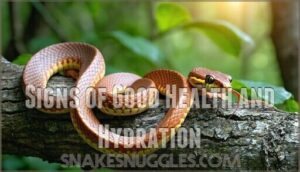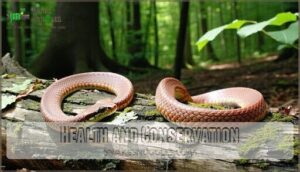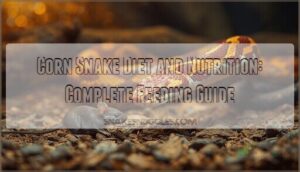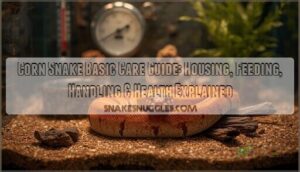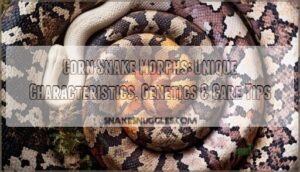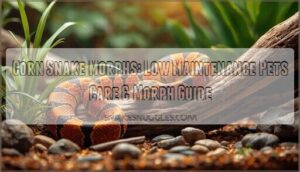This site is supported by our readers. We may earn a commission, at no cost to you, if you purchase through links.
 You’ll find corn snake species information reveals these colorful serpents are nature’s gentle giants of the reptile world.
You’ll find corn snake species information reveals these colorful serpents are nature’s gentle giants of the reptile world.
Native to southeastern United States, they’re docile constrictors that grow 30-48 inches long and live up to 20 years in captivity.
Their scientific name, Pantherophis guttatus, reflects their spotted pattern that resembles Indian corn kernels.
These nocturnal hunters feed on rodents, birds, and eggs in the wild.
They’re incredibly popular pets because they rarely bite and tolerate handling well, making them perfect for beginners, though proper housing requirements can make or break your success with these beautiful snakes.
Table Of Contents
- Key Takeaways
- Corn Snake Overview
- Corn Snake Behavior
- Housing and Care
- Diet and Nutrition
- Health and Conservation
- Frequently Asked Questions (FAQs)
- Are corn snakes venomous?
- How do corn snakes hunt?
- Are corn snakes aggressive?
- Where do corn snakes live?
- What do corn snakes eat?
- How long do corn snakes live?
- What are the differences between a coral snake and a corn snake?
- How many species of corn snakes are there?
- What are some interesting facts about corn snakes?
- Are corn snakes harmless?
- Conclusion
Key Takeaways
- You’ll find corn snakes are perfect beginner pets because they’re docile, non-venomous constrictors that rarely bite and tolerate handling well, making them ideal for families and new reptile owners.
- You need to maintain a proper temperature gradient of 85°F on the basking side and 75°F on the cool side, along with secure hiding spots and escape-proof enclosures since they’re skilled escape artists.
- You should feed juveniles twice weekly and adults every 7-14 days with appropriately-sized rodents, while providing fresh water daily in a shallow, stable bowl for drinking and soaking.
- You can expect your corn snake to live 20-30 years in captivity with proper care, growing 3-5 feet long and displaying beautiful orange-red patterns that resemble corn kernels.
Corn Snake Overview
Corn snakes are non-venomous, slender reptiles native to the southeastern United States, known for their striking orange-red patterns and gentle temperament.
These beautiful, docile snakes make perfect companions for reptile enthusiasts seeking a calm, colorful pet that’s easy to care for.
They’re great beginner snakes, thriving in diverse habitats and living up to 20 years in captivity with proper care.
Native Habitat and Distribution
If you’re in the southeastern United States, chances are you’ve walked through prime corn snake habitat.
These adaptable snakes thrive in varied environments—from pine forests and rocky hillsides to urban parks and farmland. Their snake distribution stretches from southern New Jersey to Florida, west to Louisiana, and parts of Kentucky.
Whether hiding in mammal burrows, under logs, or even near suburban homes, their habitat types reflect impressive adaptability.
Interestingly, introduced populations can be found in the Caribbean, Europe, and even the Virgin Islands. Regional variations in color make these snakes even more fascinating—those in higher elevations tend to be browner, while others showcase brilliant orange tones.
With their natural pest control benefits, corn snakes are champions for ecosystems throughout their range, providing a valuable service by controlling pest populations in a natural and environmentally friendly way.
Average Length and Lifespan
Corn snakes typically reach a length of 3-5 feet, though some exceptional individuals may hit 6 feet.
Their growth rate depends on diet and care, with maturity age usually around 2 years.
In nature, their wild lifespan is 6-15 years due to predators and environmental challenges.
However, with proper care, the captive lifespan stretches to 20-30 years—a guarantee of good husbandry.
Keeping your corn snake healthy can guarantee impressive size variation and a robust snake lifespan, which is directly related to the snake’s overall health.
Scientific Name and Classification
Stepping away from lifespan details, let’s explore the corn snake’s scientific name, Pantherophis guttatus, and its rich taxonomic history. Once labeled Elaphe guttata, its classification reflects an intriguing genetic lineage.
- Subspecies Debate: Two recognized types—P. guttatus guttatus and P. guttatus emoryi.
- Evolutionary Relationships: Closely linked to North American rat snakes.
- Genetic Diversity: Remarkable adaptability stems from hybridization potential.
This snake classification reveals unique connections within nature!
Corn Snake Behavior
Corn snakes are known for their calm, curious nature, making them one of the most approachable snake species to observe or handle.
They’re solitary and non-venomous but can still surprise you with their clever escape attempts when they feel threatened.
Docile Nature and Handling
Corn snakes are some of the most beginner-friendly reptiles, thanks to their calm, docile nature.
With gentle handling, these snakes rarely show aggression, making them an excellent choice for families, including those with kids.
Approach handling gradually—start with 5-10 minutes a day to help them feel safe. Move slowly and support their body to reduce bite risk. Over time, many corn snakes recognize their handlers, forming a bond.
Here’s a quick guide:
| Action | Why It Matters | Tips |
|---|---|---|
| Begin Slowly | Builds trust and reduces stress | Keep sessions short at first. |
| Use Gentle Movements | Prevents defensive reactions | Support their full body. |
| Handle Regularly | Encourages a calm temperament | Stay consistent over time. |
These curious, docile snakes thrive with safe interaction and enjoy engaging with patient handlers.
Defense Mechanisms and Escape Attempts
In terms of defense, corn snakes are crafty escape artists with fascinating tricks up their scales.
They’ll vibrate their tails, mimicking rattlesnake warnings to startle predators, or release a foul-smelling musk as an effective deterrent.
Camouflage tactics help them blend seamlessly into their surroundings, offering an edge during a flight response.
If spotted, they’ll slip into tight burrow hiding spaces with ease.
Even during shedding, these clever snakes use every tool in their defense arsenal.
- Tail vibration mimics dangerous snakes.
- Musk release creates a smelly diversion.
- Camouflage tactics guarantee near invisibility.
- Burrow hiding secures fast retreats.
Activity Patterns and Nocturnal Behavior
Twilight hours are your snake’s prime time. As crepuscular creatures, corn snakes thrive in the soft light of dawn and dusk, with occasional night explorations.
They’re nocturnal hunters, relying on instinct and circadian cycles. When the season changes or during brumation, activity decreases, and burrowing becomes frequent. By day, you might catch them resting or lazily basking.
Here’s a glimpse of their daily rhythms:
| Time of Day | Activity | Behavior |
|---|---|---|
| Dawn/Dusk | Hunting/Exploring | High Movement |
| Daylight | Resting/Basking | Low Activity |
| Night | Hunting | Moderate Activity |
Housing and Care
When housing a corn snake, you’ll need an escape-proof enclosure with adequate space for natural behaviors like climbing and hiding.
Keep the habitat clean and maintain proper temperatures to guarantee your snake stays healthy and comfortable.
Suitable Enclosures and Lid Security
A well-planned snake enclosure starts with the right size and secure features.
A 20-gallon tank works fine for young or smaller snakes, but adults need at least 5.6 square feet.
Secure enclosures are a must because corn snakes are expert escape artists.
Use screen tops with escapeproof lids that lock tightly—clip-style locks or locking mechanisms work wonders.
Think about durability, too.
Glass or PVC tanks are perfect because they’re sturdy and easy to clean.
Don’t skimp on ventilation needs; screened tops provide great airflow.
For added security measures, install magnetic alarms or clamps.
A spacious, well-ventilated, escape-proof enclosure is the safest, most suitable space for your snake.
Keep escape-prevention a priority!
Temperature Gradient and Basking Site
Maintaining the right temperature gradient in your corn snake’s enclosure is like providing them with their own climate control.
Essential temperatures are key: keep the basking site at 85°F and the cool side around 75°F. This range lets them thermoregulate and stay active.
Use basking lamps or other reliable heat sources, but avoid heat rocks—they can scorch your snake. Thermostat control is a must to prevent overheating. Place thermometers on both ends to monitor the gradient daily.
A vital component for maintaining this is a reliable corn snake thermostat. Think of it as creating a cozy home:
- **Warmth on one side, cool relief on the other.
- **Thermostats keep everything just right.
- **Daily checks guarantee a healthy, happy snake.
Hiding Places and Climbing Structures
Your corn snake’s enclosure should feel like a cozy, miniature jungle. Alongside warmth, it needs safe hides for resting and climbing structures for exploration. Place one hide on the warm side and another on the cool. Add climbing branches to challenge their agility and offer exercise.
Here’s how to create an enriched snake habitat:
- Use suitable enclosures with dense foliage or tree bark for secure hiding places.
- Add varied substrate depths to mimic burrowing in nature.
- Incorporate climbing structures like forked branches for habitat complexity and fun.
Snakes require appropriate safe and secure hides to reduce stress. Branch placement makes all the difference—think playground, not confinement!
Diet and Nutrition
Feeding your corn snake the right diet is essential for its health and well-being.
These snakes thrive on small prey like mice, and understanding their nutritional needs guarantees they stay active and healthy.
Carnivorous Diet and Prey Items
Corn snakes thrive on a carnivorous diet, mostly consisting of rodents, lizards, small birds, and reptile eggs.
These skilled hunters have impressive techniques—they’re great climbers and can ambush prey on the ground.
Watching them hunt is like nature’s own suspenseful drama.
They’ll either constrict their prey or snatch it in an instant.
Prey size matters! Always choose items no wider than the thickest part of your snake’s body.
Juveniles usually prefer smaller meals, like pinky mice or tree frogs, while adults can handle larger prey like adult mice.
For pet owners, quality snake food guarantees proper nutrition.
Ultimately, a balanced snake diet helps maintain health, promotes natural hunting instincts, and plays a role in effective rodent control!
Feeding Schedule and Water Requirements
A corn snake’s feeding schedule depends on its age: juveniles eat snake food twice weekly, while adults eat prey items every 7–14 days.
Always match prey size to your snake’s girth. For convenient options, consider browsing corn snake food.
Hydrate with a water bowl that’s:
- Clean daily—fresh water prevents illness.
- Soak-suitable—aids shedding hydration.
- Stable and shallow—avoids spills.
Signs of Good Health and Hydration
A healthy snake shows its vibrance through clear eyes, regular tongue flicks, and smooth, deliberate movements.
Their scales should shine and shed seamlessly in a single piece—an important indicator of proper hydration and shedding quality. Firm, plump muscles and adequate skin elasticity help guarantee your pet isn’t dehydrated or malnourished.
Check that the snake maintains a healthy weight—neither too thin nor overly plump. Regular urination and a solid appetite are additional signs of good health, hinting at proper hydration.
If you notice dull eyes, retained skin after shedding, or sagging skin, something could be off. Stay proactive by scheduling regular check-ups with a reptile veterinarian. Healthy snakes thrive with attentive care, fresh water, and close observation!
Health and Conservation
You’ll want to keep your corn snake healthy by watching for signs of common issues like respiratory infections or mites.
Conservation efforts are equally important, as habitat loss and human activity can impact their wild populations.
Common Health Issues and Diseases
Your snake’s health depends on recognizing common health issues.
Watch for respiratory infections, scale rot, and parasites—external mites or internal ones affecting droppings.
Obesity from overfeeding and regurgitation after meals are signs to address.
Skin problems like poor shedding or blisters signal improper care.
Parasite prevention and prompt snake veterinarian visits are vital for reptile health.
Regular monitoring helps guarantee your corn snake thrives, avoiding conditions like metabolic bone disease that develop from poor care.
Recognizing these issues and taking preventive measures is crucial for your snake’s well-being, and ensuring a long and healthy life for your corn snake.
Veterinary Check-ups and Preventive Care
Neglecting your snake’s health is like skipping dentist appointments—little issues can turn into big problems fast.
Regular veterinary check-ups are the cornerstone of good snake care. A reptile-savvy veterinarian guarantees your snake thrives and avoids common health issues. Annual exams catch respiratory infections early, monitor shedding, and prevent bigger complications.
Here’s how to stay ahead:
- Follow quarantine protocols for new snakes to stop disease spread.
- Practice parasite control using routine fecal testing.
- Keep shedding smooth—troubles often point to deeper concerns.
- Look out for signs of infection, like wheezing or nasal bubbles.
- Record weight, behavior, and feeding—consistency signals good snake health.
A snake veterinarian is your co-pilot for preventive care, guaranteeing your slithery friend stays lively and alert!
Conservation Status and Human Impact
Despite their "Least Concern" IUCN status, wild corn snakes face numerous human-driven threats.
Even with stable populations, corn snakes battle habitat loss and human misunderstanding in their fight for survival.
Habitat loss from urban development fragments their forest homes, shrinking hunting grounds.
Public perception doesn’t help either—misidentification leads to fear-based killings, with some mistaking them for venomous copperheads.
The pet trade has also historically hurt wild populations, though today, captive breeding programs reduce this human impact.
Conservation efforts are on the rise.
Protected areas, wildlife corridors, and public education are addressing these issues.
You can contribute too: never release pets into the wild to prevent introducing invasive species, and support snake conservation initiatives.
After all, these beautiful snakes aren’t just harmless—they’re essential for controlling rodent populations in their natural habitats.
Frequently Asked Questions (FAQs)
Are corn snakes venomous?
No, you don’t need to worry—corn snakes aren’t venomous, aren’t dangerous, and aren’t aggressive.
These harmless constrictors make excellent pets and actually help control rodent populations around your property naturally.
How do corn snakes hunt?
You’ll find corn snakes are patient hunters who use constriction to subdue prey.
They’ll stalk rodents, birds, and small animals both on ground and in trees, wrapping around victims until suffocation occurs.
Are corn snakes aggressive?
Like gentle giants in miniature form, corn snakes are remarkably docile creatures.
You’ll find they’re non-aggressive by nature, preferring to flee rather than fight.
They’re naturally calm, making them excellent pets for beginners.
Where do corn snakes live?
You’ll find corn snakes throughout the southeastern United States, from New Jersey down to Florida and west to Louisiana. They love pine forests, farmlands, abandoned buildings, and anywhere rodents gather.
What do corn snakes eat?
Corn snakes are absolutely voracious predators! You’ll find they primarily hunt rodents like rats and mice, but they’ll also snack on small birds, lizards, frogs, and eggs when available.
How long do corn snakes live?
You’ll be amazed by your corn snake’s longevity!
In captivity, they typically live 20-30 years with proper care.
While wild corn snakes average 6-15 years due to predators and environmental challenges.
What are the differences between a coral snake and a corn snake?
You’ll easily distinguish them by remembering "red touches black, friend of Jack" for harmless corn snakes versus "red touches yellow, kills a fellow" for deadly coral snakes.
Corn snakes are longer, docile constrictors.
How many species of corn snakes are there?
Picture yourself peering into nature’s rainbow of serpentine beauty.
You’ll discover there’s actually just one species of corn snake, Pantherophis guttatus, but selective breeding has created over 800 stunning color morphs you can admire.
This discovery allows you to explore a wide range of color morphs.
What are some interesting facts about corn snakes?
You’ll find these fascinating reptiles don’t actually eat corn despite their name.
They’re excellent climbers, can live over 20 years in captivity, and their belly patterns resemble corn kernels—hence the nickname.
Are corn snakes harmless?
While venomous snakes strike fear into hearts, you’ll find corn snakes are completely harmless to humans.
They’re non-venomous constrictors that might bite defensively, but they can’t inject toxins or cause serious injury.
Conclusion
Despite their intimidating serpentine appearance, corn snakes rank among the most beginner-friendly reptiles you’ll encounter.
This detailed corn snake species information demonstrates why they’ve captured hearts worldwide—from their docile temperament to straightforward care requirements.
You’ll discover that success hinges on maintaining proper temperatures, providing secure hiding spots, and establishing consistent feeding schedules.
Whether you’re considering your first snake or expanding your collection, corn snakes offer rewarding companionship that’ll teach you fundamental reptile husbandry skills for decades, making them ideal for learning proper temperatures and care.







